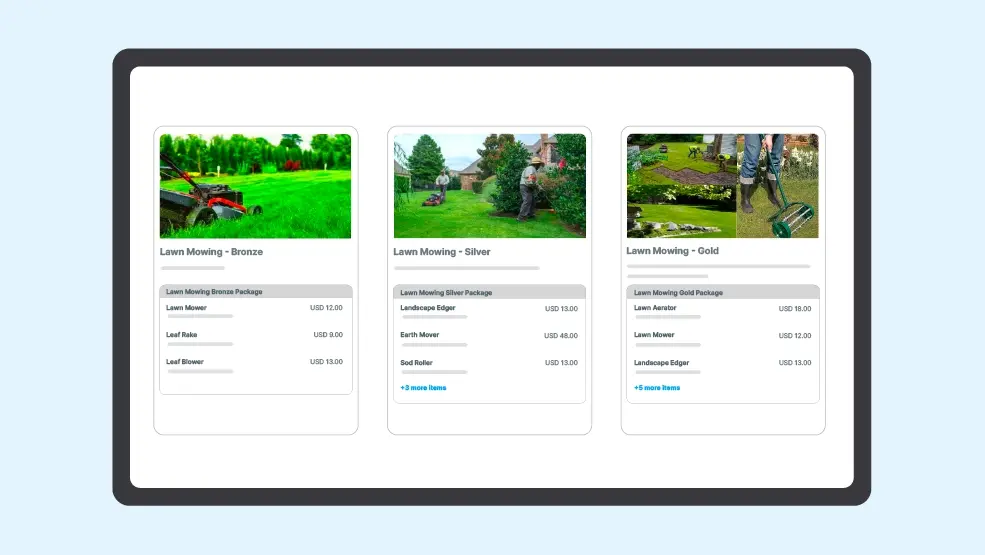The pricing strategy of lawn care services can make or break your residential lawn care service. Deciding a proper rate for your services helps you propagate your business speedily, meeting success in the near future. The way you price your service also impacts the number of clients you attract and the profit you make. So, it becomes really important to start on a good note. The article will help you understand the pricing of your lawn care services so that you can have a profitable start to your business. Follow the 8-step process listed below to price your residential lawn care services at your best.
Factors to consider when setting lawn care prices
When you set prices for lawn care, think about how much it costs to do the work, like pay for workers, things you need, and tools. Also, think about costs that are not direct, like having insurance and bills. If the work is hard, like planning gardens or taking care of trees, you might need to ask for more money because it needs special skills.
At different times of the year, you might need to change how much you want to be paid. It’s good to look at how much other people ask for so you can be like them and to know how much the people you want to work for can spend. Think about how often the job needs to be done, where it is, and if there’s anything extra you offer, like putting some jobs together. And in the end, don’t forget to add some money so you can keep the job going and make it grow.
Different times of year affect how much lawn work costs. It’s important to know these changes to charge fair prices and manage your business well. Let’s look at how seasons impact lawn care prices.
Seasonality and lawn care prices
| Season | Demand | Services | Pricing Strategy |
| Spring | High Demand | Spring cleanups, aeration, fertilization | Higher prices due to increased demand |
| Summer | Steady | Mowing, weed control, irrigation maintenance | Stable prices, consider maintenance packages |
| Autumn | High | Leaf removal, pruning, winterization | Premium prices for specialized services |
| Winter | Low | Snow removal (optional) | Prices depend on winter severity and demand |
Step 1: Keep a tap on time spent
Keep track of the time spent to complete a particular task. This step becomes the heart of pricing your services. You may either keep a tap on the time spent or use tech-driven tools to make your job easier. For example, If two separate properties, each of them measuring 7500 sq. ft. be A and B. It takes you 20 minutes to mow A, and 40 minutes to mow B. You must charge double the price of A for mowing B.
Step 2: Identify your target market
Keep your eyes all around to check what other dealers are offering and at what prices. If you have a successful service provider near you, check what makes him stand out and try to inculcate better plans in your services.Develop contacts with the service providers in your target market and understand their pricing plans. This will help you frame profitable pricing for your own lawn care service.
Step 3: Calculate all your operational costs
Calculate your operational costs that including tool maintenance, work time and fuel, and labor cost.If you don’t have any labor assigned to you, calculate your own stipend for the month. Sum up the costs and prepare a gross operational bill down the line.
To set rates that are both competitive and profitable, as a lawn care business owner, you need to calculate all their expenses accurately. It’s essential to consider both direct and indirect costs when determining overall profitability. Typical business costs that should be factored into lawn care pricing include:
| Category | Costs |
| Equipment Costs | Purchase price, maintenance, repairs, replacements, depreciation |
| Fuel and Maintenance | Gasoline, oil, equipment maintenance |
| Labor Costs | Wages, benefits, overtime pay |
| Insurance | Liability, workers’ compensation, vehicle insurance |
| Overhead Expenses | Office expenses, advertising, software, and administrative costs |
| Materials and Supplies | Fertilizers, pesticides, mulch, etc. |
| Profit Margin | Desired business profit |
| Market Research | Local competitor pricing analysis |
Source: lawnstarter.com
The complexity of lawn care services can vary significantly. More specialized tasks, like landscape design or tree care, typically require higher prices due to the specialized skills and labor involved. Additionally, your rates may need to adjust seasonally to reflect changes in demand for certain services throughout the year.
Step 4: Price special services differently
Segregate pricing for services based on their demand and specialty. Not all services require similar skills and labor. Thus, their charges should be different as well. Special services should cost 5% to 10% extra of the actual amount after covering up the operational cost.Don’t hesitate to hike the prices a little extra if you feel your work deserves the same. If you don’t feel confident enough about this, talk to your clients and seek feedback on them.
| Service type | Average costs |
| Mowing | $36 to $105 |
| Aeration | $78 to $238 |
| Weeding | $65 to $120 |
| Fertilization | $103 to $343 |
| Yard Cleanup | $109 to $1,089 |
| Leaf removal | $165 to $485 |
| Tree trimming | $315 – $700 per tree |
| Mulching | $20 – $45 per cubic yard |
Source: lawnstarter.com
Step 5: Estimate your profitability
Estimating your profit becomes a motivating factor to grow your business. Figure out how much profit you will be making after covering up all the operational costs. Don’t forget to educate yourself on the services that are more profitable.
Step 6: Don’t forget to factor in taxes
Adding tax after your lawn care quote is an indispensable task. You may also add up the tax in the client invoices. Adding the tax helps you prepare accurate bills of your services. It also increases your kids’ credibility and portrays you as a legal businessperson.
Step 7: Test-run your pricing
Test running your pricing is basically setting your price to target both high-class and average customers. If your prices are too high the average population will not be able to meet it. Too low prices can again spoil your business and profit margins.Thus, it becomes necessary to target both types of clients and set a middling price. You can compare and adjust your prices with other competitors too.
Step 8: Lock the figures!
Once you have chosen the pricing and the cost that you want to charge your customers, finalize the figures.Stay confident about your calculations and costs even if you are the only lawn service provider with the cost. What matters is that your service justifies the prices.At the end of the day, you should have a sufficient margin for yourself while also providing valuable and satisfactory service for your customers. The pricing and the service should strike a balance so that neither you nor your customer feels disappointed.Finally,
When do you need to re-adjust your pricing figures?
Readjustment of prices depends upon service rates, time of service, area of service, and business needs. You may consider changing or re-adjusting the pricing under one of these circumstances.
- If your services are based on packages such as mowing, trimming, pruning, hedging, watering during certain months, removing snow every fortnight, or once every month during warm months, you would want to set the prices according to packages.
- If the task that you have been offered to do requires more labor and skill than what you had previously assumed, charge for the extra labor.
- If the area of service is large and it requires more gas, you must consider adding up the cost of extra gas invested.
- In case you plan to charge a certain collective amount to the lawn areas that fall in the same region or area, you will have to readjust your pricing.
- Services such as fertilization or application of herbicides and pesticides require less labor. So, you may want to adjust the pricing depending upon the labor and the supply charges.
- If you have been given a special time limit or a short time period to carry out a task that would have otherwise required more time, you must apply special charges here.
- If you are expected to do an extra service, don’t forget to include the pricing or charge of that service as well.
Offer packaged plans
Many lawn experts use bundle deals to serve their customers better. These deals combine different services like mowing, fertilizing, and aeration into one package. Customers then pay a fixed amount for these combined services. This way, they get all they need without the trouble of paying for each service separately. It’s like buying in bulk and it makes regular lawn upkeep simpler and potentially more affordable.

Conclusion
Once you have planned your pricing and you are done with the readjustment, do not keep shifting your prices all the time. Yes, you may want to increase or decrease your charges depending upon the season and the availability of customers.For example, if you are getting fewer customers in a season, you can reduce the prices but not insanely. Working for free or no cost is simply not an option here.Remember, your work not just requires labor, it also requires capital investments. Above all make sure you guarantee your customer that your servicing is as profitable for them as it can get. And if you still fail to manage everything… why don’t you give Zuper a chance? It’s the best field service management software you will ever find!



